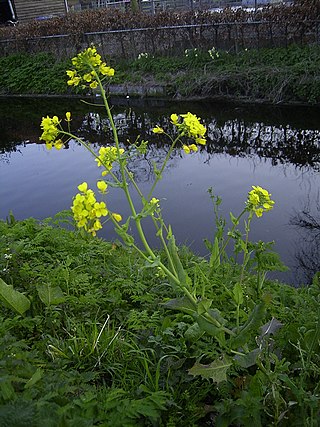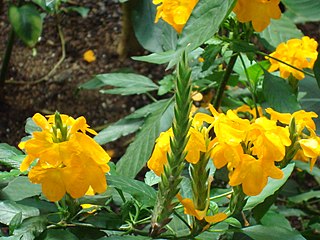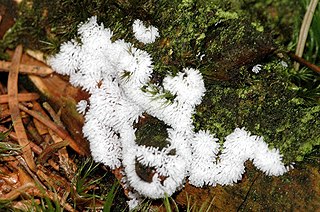
Brassica is a genus of plants in the cabbage and mustard family (Brassicaceae). The members of the genus are informally known as cruciferous vegetables, cabbages, or mustard plants. Crops from this genus are sometimes called cole crops—derived from the Latin caulis, denoting the stem or stalk of a plant.

Ochna is a genus comprising 86 species of evergreen trees, shrubs and shrublets belonging to the flowering plant family Ochnaceae. These species are native to tropical woodlands of Africa, Madagascar, the Mascarenes and Asia. Species of this genus are usually called ochnas, bird's-eye bushes or Mickey-mouse plants, a name derived from the shape of the drupelet fruit. The name of this genus comes from the Greek word Ochne, used by Homer and meaning wild pear, as the leaves are similar in appearance. Some species, including Ochna integerrima and O. serrulata, are cultivated as decorative plants.

Muehlenbeckia or maidenhair is a genus of flowering plants in the family Polygonaceae. It is native to the borders of the Pacific, including South and North America, Papua New Guinea and Australasia. It has been introduced elsewhere, including Europe. Species vary in their growth habits, many being vines or shrubs. In some environments, rampant species can become weedy and difficult to eradicate.

Portulacaria is a genus of succulent plant, classified in its own subfamily Portulacarioideae in the family Didiereaceae. It is indigenous to southern Africa.

Frankenia pauciflora, the common sea-heath or southern sea-heath, is an evergreen shrub native to southern Australia. It is part of the Frankenia genus of the Frankeniaceae family.

Crossandra is a genus of plants in the family Acanthaceae, comprising 54 species that occur in Africa, Madagascar, Arabia and the Indian subcontinent. Some species, especially Crossandra infundibuliformis, are cultivated for their brightly colored flowers.

Ceratiomyxa is a genus of plasmodial slime mould within the Eumycetozoa, first described by Pier Antonio Micheli. They are widely distributed and commonly found on decaying wood.

Brassica fruticulosa, the Mediterranean cabbage or twiggy turnip, is a member of the agriculturally significant genus Brassica. It was described by Domenico Maria Leone Cirillo in 1792.

Echinopora is a genus of stony corals in the family Merulinidae.

Echinopora fruticulosa is a species of stony coral in the family Merulinidae.
Trichopteryx is a genus of African plants in the grass family.

Portulacaria fruticulosa is a succulent plant found on the border between Namibia and South Africa.
Aspergillus fructiculosus is a species of fungus in the genus Aspergillus. The species was first described in 1965. It has been reported to produce sterigmatocystin.
Achyropsis is a genus of plants in the amaranth family, Amaranthaceae that is found in Africa distributed from Kenya to South Africa.
Gintaras Kantvilas is an Australian lichenologist, who earned his Ph.D in 1985 from the University of Tasmania with a thesis entitled Studies on Tasmanian rainforest lichens. He has authored over 432 species names, and 167 genera in the field of mycology.
Allmaniopsis is a genus of flowering plants belonging to the family Amaranthaceae.
Cyathobasis is a genus of flowering plants belonging to the family Amaranthaceae.

Matthiola fruticulosa, the sad stock or dark-flowered stock, is a species of flowering plant in the family Brassicaceae, native to the Mediterranean region. It is adapted to clay and marl soil types.
Phycopsis is a genus of sponges belonging to the family Axinellidae. The species of this genus are found in Malesia and Australia.










